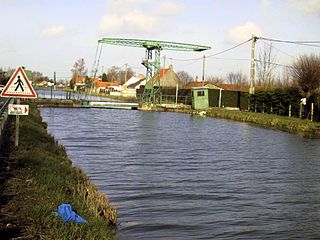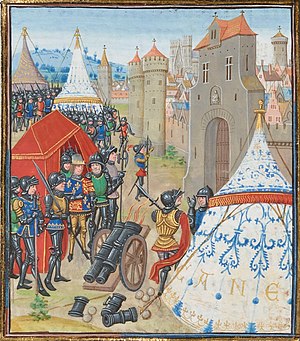
Edward of Woodstock, known to history as the Black Prince, was the eldest son and heir apparent of King Edward III of England. He died before his father and so his son, Richard II, succeeded to the throne instead. Edward nevertheless earned distinction as one of the most successful English commanders during the Hundred Years' War, being regarded by his English contemporaries as a model of chivalry and one of the greatest knights of his age.

Charles V, called the Wise, was King of France from 1364 to his death in 1380. His reign marked an early high point for France during the Hundred Years' War, with his armies recovering much of the territory held by the English, and successfully reversed the military losses of his predecessors.

John II, called John the Good, was King of France from 1350 until his death in 1364. When he came to power, France faced several disasters: the Black Death, which killed nearly one-third to one-half of its population; popular revolts known as Jacqueries; free companies of routiers who plundered the country; and English aggression that resulted in catastrophic military losses, including the Battle of Poitiers of 1356, in which John was captured.

The Treaty of Brétigny was a treaty, drafted on 8 May 1360 and ratified on 24 October 1360, between Kings Edward III of England and John II of France. In retrospect, it is seen as having marked the end of the first phase of the Hundred Years' War (1337–1453) as well as the height of English power on the European continent.
The Treaty of London was proposed by England, accepted by France, and signed in 1359. After Edward the Black Prince soundly defeated the French at Poitiers, where they captured John II of France, the French king was forced to accept the terms of the English. Based on the terms of the accord, England was permitted to annex much of western France, including Normandy, Anjou, Maine, Aquitaine within its ancient limits, Calais and Ponthieu, as well as suzerainty over the Duchy of Brittany. This would restore the ancient territories of Henry II, and in full sovereignty rather than as a fief. In addition, France would pay a ransom of four million écus for the king.

Guînes is a commune in the northern French department of Pas-de-Calais. Historically it was spelt Guisnes.

Ponthieu was one of six feudal counties that eventually merged to become part of the Province of Picardy, in northern France. Its chief town is Abbeville.

From the 1340s to the 19th century, excluding two brief intervals in the 1360s and the 1420s, the kings and queens of England and Ireland also claimed the throne of France. The claim dates from Edward III, who claimed the French throne in 1340 as the sororal nephew of the last direct Capetian, Charles IV. Edward and his heirs fought the Hundred Years' War to enforce this claim, and were briefly successful in the 1420s under Henry V and Henry VI, but the House of Valois, a cadet branch of the Capetian dynasty, was ultimately victorious and retained control of France, except for Calais and the Channel Islands. English and British monarchs continued to prominently call themselves kings of France, and the French fleur-de-lis was included in the royal arms. This continued until 1802, by which time France no longer had any monarch, having become a republic. The Jacobite claimants, however, did not explicitly relinquish the claim.

The first phase of the Hundred Years' War between France and England lasted from 1337 to 1360. It is sometimes referred to as the Edwardian War because it was initiated by King Edward III of England, who claimed the French throne in defiance of King Philip VI of France. The dynastic conflict was caused by disputes over the French feudal sovereignty over Aquitaine and the English claims over the French royal title. The Kingdom of England and its allies dominated this phase of the war.

Arnoul d'Audrehem was a Marshal of France, who fought in the Hundred Years' War.
The ransom of John II of France was an event during the Hundred Years War, between France and England. King John was captured by the English during the Battle of Poitiers in 1356, and held for ransom by the English crown. Finally settled in the Treaty of Brétigny in 1360, the ransom of John II had serious consequences for the ongoing degradation of the stability of France and helped increase English influence during the war.

The Caroline War was the second phase of the Hundred Years' War between France and England, following the Edwardian War. It was so-named after Charles V of France, who resumed the war nine years after the Treaty of Brétigny. The Kingdom of France dominated this phase of the war.

The Pale of Calais was a territory in northern France ruled by the monarchs of England from 1347 to 1558. The area, which was taken following the Battle of Crécy in 1346 and the subsequent siege of Calais, was confirmed at the Treaty of Brétigny in 1360. It became an important economic centre for England in Europe’s textile trade centred in Flanders.

The Hundred Years' War was a series of armed conflicts fought between the kingdoms of England and France during the Late Middle Ages. It originated from English claims to the French throne. The war grew into a broader power struggle involving factions from across Western Europe, fueled by emerging nationalism on both sides. The periodization of the war takes place over 116 years, wherein the war was interrupted by several years of truces.
The crown lands, crown estate, royal domain or domaine royal of France were the lands, fiefs and rights directly possessed by the kings of France. While the term eventually came to refer to a territorial unit, the royal domain originally referred to the network of "castles, villages and estates, forests, towns, religious houses and bishoprics, and the rights of justice, tolls and taxes" effectively held by the king or under his domination. In terms of territory, before the reign of Henry IV, the domaine royal did not encompass the entirety of the territory of the kingdom of France and for much of the Middle Ages significant portions of the kingdom were the direct possessions of other feudal lords.

A free company was an army of mercenaries between the 12th and 14th centuries recruited by private employers during wars. They acted independently of any government, and were thus "free". They regularly made a living by plunder when they were not employed; in France they were called routiers and écorcheurs and operated outside the highly structured law of arms. The term "free company" is most often applied to those companies of soldiers which formed after the Peace of Brétigny during the Hundred Years' War and were active mainly in France, but it has been applied to other companies, such as the Catalan Company and companies that operated elsewhere, such as in Italy and the Holy Roman Empire.

The dual monarchy of England and France existed during the latter phase of the Hundred Years' War when Charles VII of France and Henry VI of England disputed the succession to the throne of France. It commenced on 21 October 1422 upon the death of King Charles VI of France, who had signed the Treaty of Troyes which gave the French crown to his son-in-law Henry V of England and Henry's heirs. It excluded King Charles's son, the Dauphin Charles, who by right of primogeniture was the heir to the Kingdom of France. Although the Treaty was ratified by the Estates-General of France, the act was a contravention of the French law of succession which decreed that the French crown could not be alienated. Henry VI, son of Henry V, became king of both England and France and was recognized only by the English and Burgundians until 1435 as King Henry II of France. He was crowned King of France on 16 December 1431.
The Truce of Calais was a truce agreed by King Edward III of England and King Philip VI of France on 28 September 1347, which was mediated by emissaries of Pope Clement VI. The Hundred Years' War had broken out in 1337 and in 1346 Edward had landed with an army in northern France. After inflicting a heavy defeat on Philip and a French army at the Battle of Crécy the English besieged Calais, which fell after 11 months. Both countries were financially and militarily exhausted and two cardinals acting for Pope Clement were able to broker a truce in a series of negotiations outside Calais. This was signed on 28 September to run until 7 July 1348.
The Treaty of Guînes was a draft settlement to end the Hundred Years' War, negotiated between England and France and signed at Guînes on 6 April 1354. The war had broken out in 1337 and was further aggravated in 1340 when the English king, Edward III, claimed the French throne. The war went badly for France: the French army was heavily defeated at the Battle of Crécy, and the French town of Calais was besieged and captured. With both sides exhausted, a truce was agreed that, despite being only fitfully observed, was repeatedly renewed.
Eustace d'Aubrichecourt or d'Abrichecourt or d'Auberchicourt, of the Auberchicourt family, was a French knight who enlisted in the service of the English during the Hundred Years' War. His knightly exploits were recorded by Froissart.














